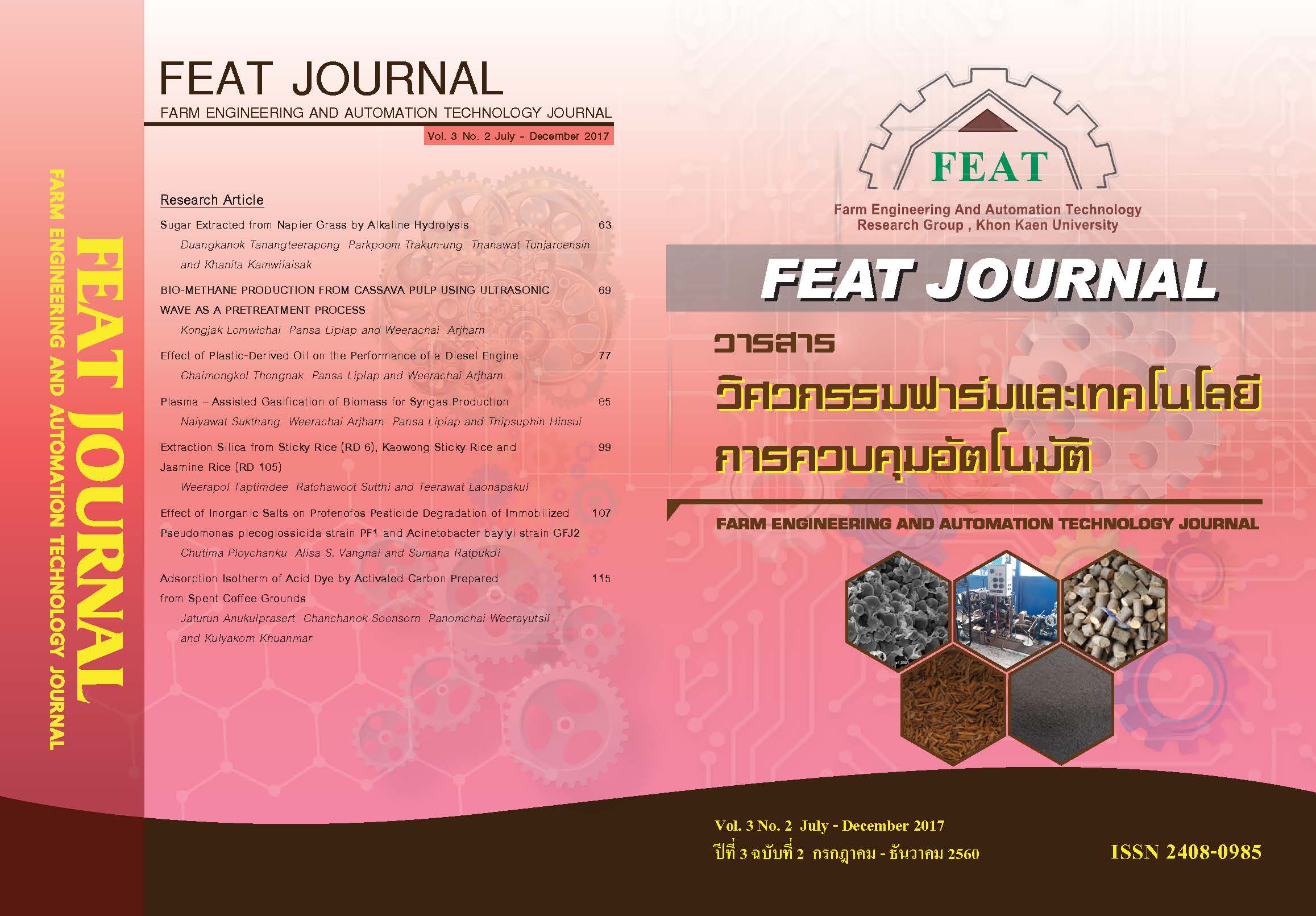การผลิตแก๊สสังเคราะห์จากชีวมวลโดยใช้กระบวนการพลาสมาแก๊สซิฟิเคชั่น
Main Article Content
บทคัดย่อ
งานวิจัยนี้มีวัตถุประสงค์เพื่อทดสอบการผลิตพลังงานจากเชื้อเพลิงไม้กระถินยักษ์สับท่อนความชื้นสูง ด้วยระบบพลาสมาแก๊สซิฟิเคชั่น พบว่าระบบสามารถลดข้อจำกัดด้านความชื้นในวัตถุดิบได้ โดยความชื้นของเชื้อเพลิงอาจทำให้อุณหภูมิเฉลี่ยในเตาปฏิกรณ์ลดลง แต่มีผลต่อการเพิ่มองค์ประกอบของ H2 ในแก๊สเชื้อเพลิง ได้ค่าความร้อนอยู่ในระดับสูง (> 5 MJ/N m3) และมีคุณภาพตามเกณฑ์มาตรฐานสำหรับการนำแก๊สเชื้อเพลิงไปใช้ประโยชน์ อีกทั้งยังคงประสิทธิภาพเทียบเคียงได้กับการใช้เชื้อเพลิงที่ระดับความชื้นต่ำ และเมื่อพิจารณาในกรณีการผลิตพลังงานจากเชื้อเพลิงความชื้น 16% w.b. ซึ่งคิดรวมพลังงานในการอบแห้งด้วย พบว่าระบบพลาสมาแก๊สซิฟิเคชั่นมีประสิทธิภาพได้เปรียบระบบแก๊สซิฟิเคชั่นแบบดั้งเดิมถึง 15% แสดงให้เห็นว่าระบบพลาสมาแก๊สซิฟิเคชั่นสามารถเดินระบบโดยใช้เชื้อเพลิงชีวมวลความชื้นสูงได้อย่างมีประสิทธิภาพ และเป็นการลดขั้นตอนและพลังงานในการเตรียมเชื้อเพลิง
Article Details
วารสารวิศวกรรมฟาร์มและเทคโนโลยีควบคุมอัตโนมัติ (FEAT Journal) มีกําหนดออกเป็นราย 6 เดือน คือ มกราคม - มิถุนายน และ กรกฎาคม - ธันวาคม ของทุกปี จัดพิมพ์โดยกลุ่มวิจัยวิศวกรรมฟาร์มและเทคโนโลยีควบคุมอัตโนมัติ คณะวิศวกรรมศาสตร์มหาวิทยาลัยขอนแก่น เพื่อเป็นการส่งเสริมและเผยแพร่ความรู้ ผลงานทางวิชาการ งานวิจัยทางด้านวิศวกรรมศาสตร์และเทคโนโลยีพร้อมทั้งยังจัดส่ง เผยแพร่ตามสถาบันการศึกษาต่างๆ ในประเทศด้วย บทความที่ตีพิมพ์ลงในวารสาร FEAT ทุกบทความนั้นจะต้องผ่านความเห็นชอบจากผู้ทรงคุณวุฒิในสาขาที่เกี่ยวข้องและสงวนสิทธิ์ ตาม พ.ร.บ. ลิขสิทธิ์ พ.ศ. 2535
เอกสารอ้างอิง
[2] Han, J., and Kim H. (2008). The reduction and control technology of tar during biomass gasification/pyrolysis: An overview. Renewable and Sustainable Energy Reviews. 12(2): 397-416.
[3] Arjharn, W., Hinsui, T., Liplap, P., and G. S. V. Raghavan. (2012). Evaluation of Energy Production from Different Biomass Feedstock Using a Pilot Scale Downdraft Gasifier. Biobase Materials and Bioenergy. 6, 1-11.
[4] Rutberg, Ph.G., Bratsev, A. N., Kuznetsov, V. A., Popov, V. E., Ufimtsev, A. A., Shtengel, S. V. (2011). On efficiency of plasma gasification of wood residues. Biomass and Bioenergy. 35(1): 495-504.
[5] Hlina, M., Hrabovsky, M., Kopecky, V., Konrad, M. and Kavka, T. (2006). Plasma gasification of wood and production of gas with low content of tar. Czechoslovak Journal of Physics. 56: B1179-B1184.
[6] Zhang, L., Xu, C. C., Champagne, P. (2010). Overview of recent advances in thermo-chemical conversion of biomass. Energy Conversion and Management. 51(5): 969-982.
[7] Bhattacharya, S. C., Hla, S. S. and Pham, H. L. (2001). A study on a multi-stage hybrid gasifier-engine system. Biomass and Bioenergy. 21(6): 445-460.
[8] Janajreh, I., Raza, S. S., Valmundsson, A. S. (2013). Plasma gasification process: Modeling, simulation and comparison with conventional air gasification. Energy Conversion and Management. 65(0):801-809.
[9] Nakorn Tippayawong. (2010). Biomass conversion technology.Technology Promotion Association (Thailand-Japan), Bangkok, Thailand. 256 pages. (In Thai).
[10] Chotchutima, S., Tudsri, S., Kangvansaichol K. and Sripichitt, P. (2016). Effects of sulfur and phosphorus application on the growth, biomass yield and fuel properties of leucaena (Leucaena leucocephala (Lam.) deWit.) as bioenergy crop on sandy infertile soil. Agriculture and Natural Resources. 50: 54-59.
[11] Rengsirikul, K., Kanjanakuha, A., Ishii, Y., et al. (2011). Potential forage and biomass production of newly introduced varieties of Leucaena (Leucaena leucocephala (Lam.) de Wit.) in Thailand. Grassl. Sci. 57: 94-100.
[12] Quaak, P., Knoef, H. and Stassen, H. (1999). Energy from biomass: A review of combustion and gasification technology. World bank techpaper. no.422.
[13] Reed, T. B., and Das, A. (1988). Handbook of Biomass Downdraft Gasifier Engine System, Solar Energy Research Institute, Golden, Colorado.
[14] Rajvanshi, A. K. (1986). Biomass gasification, In: Goswami, Y.D. (Ed.). Alternative Energy in Agriculture, CRC Press. 83-102.
[15] Kirubakaran, V., Sivaramakrishnan, V., Nalini, R., Sekar, T., Premalatha, M., Subramanian, P. (2009). A review on gasification of biomass. Renewable and Sustainable Energy/Review, 13(1):179-186.
[16] Zainal, Z. A., Rifau, A., Quadir, G. A. and Seetharamu, K. N. (2002). Experimental investigation of a downdraft biomass gasifier. Biomass and Bioenergy. 23(4): 283-289.
[17] Sharma, A. K. (2008). Equilibrium modeling of global reduction reactions for a downdraft (biomass) gasifier. Energy Conversion and Management. 49(4): 832-842.
[18] Kaupp, A. and Goss, J. R. (1981). State of art for small scale (50 kW) to gas producer-engine systems. Final Report to the USDA USFS on Contract No. 53-319R-0-141, University of California, Davis.
[19] Devi, L., Ptasinski, K.J., Janssen, F.J.J.G. (2003). A review of the primary measures for tar elimination in biomass gasification processes. Biomass and Bioenergy. 24(2):125-140.
[20] Phuphuakrat, T.; Nipattummakul, N.; Namioka, T.; Kerdsuwan, S.; Yoshikawa, K., (2010). Characterization of tar content in the syngas produced in a downdraft type fixed bed gasification system from dried sewage. Fuel. 89:2278-2284.
[21] Weerachai Arjharn (2007). Study of a small-scale biomass power plant for rural communities (phase II). Final Report.
National research council of thailand. (In Thai).


